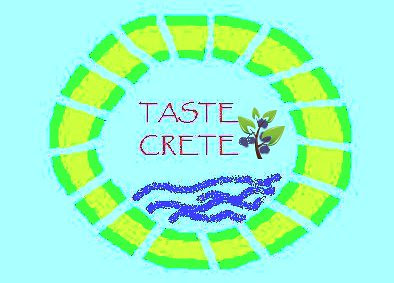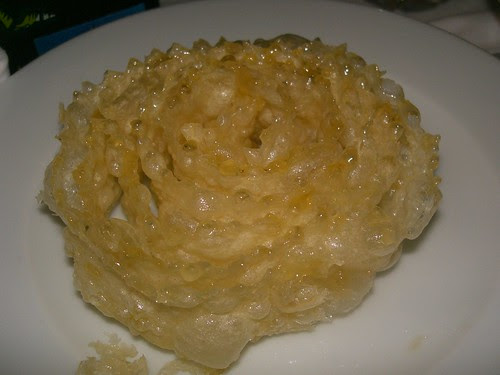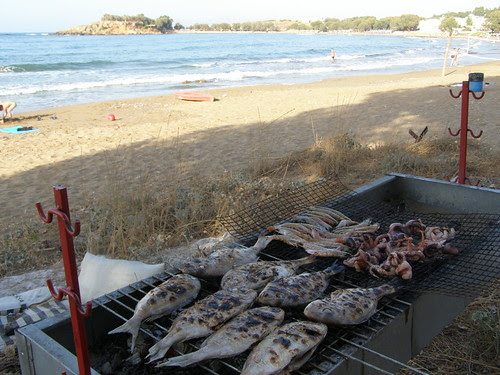Taste Crete (Γεύση Κρήτης)
Some people recently asked me for my recommendations about 'good eats' in Hania. I originally wrote this post in 2010 - it's still valid today!
 Crete is the largest island in Greece. In fact, it's large enough for the residents of the western side to display marked differences with those on the eastern side. Crete is an agriculturally-based island, with a strong dependence on summer tourism, as it offers very clean and enticing beaches and unique opportunities for agro-tourism holidays. The food of Crete alone represents a unique opportunity to get a taste for the Cretan culture, because in Crete, there is no event that is not associated with food. Although the food generally eaten all over the island is the same, each prefecture in Crete (and there are four: from west to east, they are Hania, Rethimno, Iraklio and Lasithi, whose main towns are Agios Nikolaos and Sitia) has its own regional gastronomic range.
Crete is the largest island in Greece. In fact, it's large enough for the residents of the western side to display marked differences with those on the eastern side. Crete is an agriculturally-based island, with a strong dependence on summer tourism, as it offers very clean and enticing beaches and unique opportunities for agro-tourism holidays. The food of Crete alone represents a unique opportunity to get a taste for the Cretan culture, because in Crete, there is no event that is not associated with food. Although the food generally eaten all over the island is the same, each prefecture in Crete (and there are four: from west to east, they are Hania, Rethimno, Iraklio and Lasithi, whose main towns are Agios Nikolaos and Sitia) has its own regional gastronomic range.I've gotten to know the cuisine of Hania reasonably well, having lived here for nearly two decades, and I've been cooking within the general confines of this region for the last 15 years. What I cook in my own home is what people generally cook in the locality. Cretan cuisine is based on eating fresh local seasonal produce. The food sources generally come from the island, with a few items being imported (such as potatoes, onion, lemons, pulses and flour), mainly due to the increased demand for them and the fact that people have moved away from a subsistence economy, and are now generally urban in essence. Some culinary traditions are dying out (if they haven't died out already); many of the hunter-gatherer-forager food sources previously used in the island's cuisine are now being cultivated or raised industrially, which is a natural outcome of the island's move away from farming to tourism and other urban jobs. Globalisation aside, however, Cretan cuisine remains relatively true to its origins, and its modernisation is mainly based on health concerns, such as the use of fewer fats and lipids, a decrease in the amount of olive oil used in an individual dish, and a creative use of a greater combination of fruits and vegetables in less traditional ways.
Our summer garden in all its glory
Diane Kochilas recently discussed the changing food scene is Greece, in connection with the Greek economic crisis: "The traditional fare is founded on real nutritional value and respect for the unadulterated flavors of seasonal ingredients." This is a far cry from the skordalia foam, feta ice-cream and cocktail-glass moussaka that was until recently being served at fancy over-priced Greek restaurants, mainly in the capital city. Not even the locals could feel comfortable eating such foreign-inspired concoctions. These were an attempt to 'gastronomise' the Greek food scene, in line with the general globalised climate. Thankfully, it wasn't really working, and the economic crisis has helped to fuel the breakdown of this artificial attempt to recreate one's gastronomical heritage.
If you are coming to Crete to try 'good food', then throw away the commonly held beliefs and standards. Foods mentioned in lists like the '100 foods all omnivores must try at least once in their life' are mainly unheard of on the island. The locals do not visit a taverna (what we call most of our restaurants) because of a random rave review; they are probably going there because the food is 'good' in the way that a Cretan would judge good food: on its freshness, seasonality, cooking technique, and its appropriateness. If you go to a taverna which is located in a hilly village away from the coast and you ask the waiter (who is probably the taverna owner) if kalamaria are on the menu, that's wholly inappropriate* (not to mention, kind of stupid). Before you come here, instead of asking "Where are the best places to eat?", you should be asking "What kind of food is an absolute 'must-try' while I am in Crete?"
 Seasonal local produce is above all the most important factor when looking for good food in Crete. When it grows in Cretan soil, everything tastes so good, so natural, so appropriate. A tomato smells like tomato, a watermelon tastes of watermelon, wild greens look as if they have just popped out of the red soil; it's something to do with the Mediterranean sun and the generally hospitable climate that the crops grow on, and maybe the highly scented herbs and the Mediterranean sea that give Cretan produce that special aromatic flavour that seems to be inherent in them.
Seasonal local produce is above all the most important factor when looking for good food in Crete. When it grows in Cretan soil, everything tastes so good, so natural, so appropriate. A tomato smells like tomato, a watermelon tastes of watermelon, wild greens look as if they have just popped out of the red soil; it's something to do with the Mediterranean sun and the generally hospitable climate that the crops grow on, and maybe the highly scented herbs and the Mediterranean sea that give Cretan produce that special aromatic flavour that seems to be inherent in them.Most of the fresh produce that you will find in Hania and Rethimno (the names of the main provinces in Western Crete) is home-grown; this is what makes it so good. Nearly everything is cooked in olive oil (but there are also cheapskates out there, and always pays to ask about this). Tavernas use this produce in their own food, and some tavernas even grow their own produce. So nearly everything is going to taste really good. Here is a list of 'must-try' foods that a gastroanthropologist might like to taste while touring Western Crete:
 1. kalitsounia - fried and oven-baked pastry pies and pasties, filled with greens and the local soft white cheese (mizithra) - the kalitsounia of Hania will be quite different in taste and texture than the kalitsounia of Rethimno and Iraklio, as I discover every time I visit these other towns in Crete.
1. kalitsounia - fried and oven-baked pastry pies and pasties, filled with greens and the local soft white cheese (mizithra) - the kalitsounia of Hania will be quite different in taste and texture than the kalitsounia of Rethimno and Iraklio, as I discover every time I visit these other towns in Crete.
 2. boureki - a specialty pie of Hania, not well known in Rethimno or Iraklio, practically unknown in its Cretan form in the rest of Greece, consisting of layers of potato and zucchini, cooked with the local soft white curd cheese (mizithra) and olive oil.
2. boureki - a specialty pie of Hania, not well known in Rethimno or Iraklio, practically unknown in its Cretan form in the rest of Greece, consisting of layers of potato and zucchini, cooked with the local soft white curd cheese (mizithra) and olive oil.
 3. ahinosalata - sea urchins in olive oil (if you are into kinky food). Sea urchins are not eaten all over Greece, much to even my own surprise; when we were visiting the Peloponese, we were amazed to see so many in the sea, and were shocked to discover that this expensive delicacy was allowed to rest there undisturbed!
3. ahinosalata - sea urchins in olive oil (if you are into kinky food). Sea urchins are not eaten all over Greece, much to even my own surprise; when we were visiting the Peloponese, we were amazed to see so many in the sea, and were shocked to discover that this expensive delicacy was allowed to rest there undisturbed!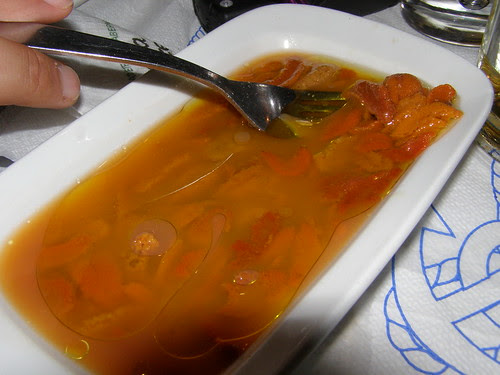
 4. anthous (stuffed zucchini flowers), often served in combination with dolmadakia (stuffed vine leaves); ask for them by name, otherwise, you will only be served the vine leaves, as these are a highly prized local dish, and there are never enough to go round.
4. anthous (stuffed zucchini flowers), often served in combination with dolmadakia (stuffed vine leaves); ask for them by name, otherwise, you will only be served the vine leaves, as these are a highly prized local dish, and there are never enough to go round.
 5. gigandes (not a local but a Greek specialty - always served as a side dish)
5. gigandes (not a local but a Greek specialty - always served as a side dish)
 6. kinky vegetables like bamies (okra)...
6. kinky vegetables like bamies (okra)...
 ... and barbounes (medium sized white beans cooked in their pods).
... and barbounes (medium sized white beans cooked in their pods).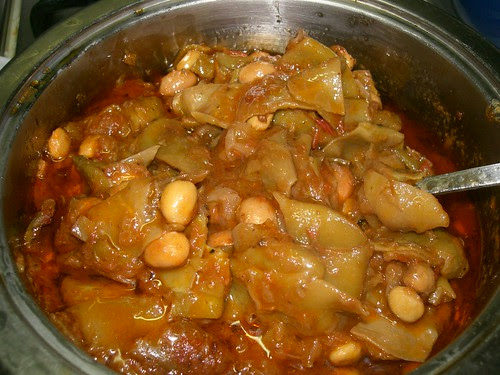
Most people know the dry or canned forms of these vegetables, so the purely educational value of trying these vegetables is probably higher than their nutritious content!
NB: I doubt you will find these vegetables cooked fresh in tavernas, but it's worth having them if you do find them (otherwise, they will be frozen, but still tasty - but not necessarily Cretan in origin).
 8. bougatsa Iordanis (cheese pie served only in Hania - this could be a breakfast meal, or a dessert, but it's quite filling). This is made fresh every day in Hania, and only sold in the morning at a particular outlet in the town. It's popular with travellers who have just arrived in Hania.
8. bougatsa Iordanis (cheese pie served only in Hania - this could be a breakfast meal, or a dessert, but it's quite filling). This is made fresh every day in Hania, and only sold in the morning at a particular outlet in the town. It's popular with travellers who have just arrived in Hania.
 9. dakos - the ubiquitous Cretan hors d'oeuvre, made with rusk, tomato and local soft white curd cheese (mizithra); this snack has become so well-known all over Greece, that you will now find it on most Greek taverna menus, maybe under the names 'koukouvayia' (meaning 'owl') and 'Kritiki salata' (Cretan salad).
9. dakos - the ubiquitous Cretan hors d'oeuvre, made with rusk, tomato and local soft white curd cheese (mizithra); this snack has become so well-known all over Greece, that you will now find it on most Greek taverna menus, maybe under the names 'koukouvayia' (meaning 'owl') and 'Kritiki salata' (Cretan salad).
 10a. marathopites - these flat seamless pies are made with fennel weed (not the bulb). They are a specialty of Hania. These days, to aid their making, cooks generally roll out the dough, and place the filling between the two pastry rounds, but there are still traditional cooks out there who make them in their more original form...
10a. marathopites - these flat seamless pies are made with fennel weed (not the bulb). They are a specialty of Hania. These days, to aid their making, cooks generally roll out the dough, and place the filling between the two pastry rounds, but there are still traditional cooks out there who make them in their more original form...
 10b. ... and mizithropites, otherwise known as Sfakianes pites - these are also flat seamless pies, this time filled with cheese and topped with local thyme honey. And once again, beware of imitations!
10b. ... and mizithropites, otherwise known as Sfakianes pites - these are also flat seamless pies, this time filled with cheese and topped with local thyme honey. And once again, beware of imitations!
 11. horiatiki salata - this isn't local (it's quintessentially Greek), but if you have one of these served with tzatziki (again Greek, not Cretan), you will think you are eating ambrosia, since all the ingredients are bound to be local; don't forget to dress the salad with olive oil and salt (and vinegar if you want), as the salad usually comes to the table without the dressing.
11. horiatiki salata - this isn't local (it's quintessentially Greek), but if you have one of these served with tzatziki (again Greek, not Cretan), you will think you are eating ambrosia, since all the ingredients are bound to be local; don't forget to dress the salad with olive oil and salt (and vinegar if you want), as the salad usually comes to the table without the dressing. 
 12. horta are simply boiled greens (vlita is seasonal in summer, while stamnagathi is in winter): instead of a Greek salad, try a plate of this, dressed with olive oil, salt and lemon - again, you will think you are eating with the gods.
12. horta are simply boiled greens (vlita is seasonal in summer, while stamnagathi is in winter): instead of a Greek salad, try a plate of this, dressed with olive oil, salt and lemon - again, you will think you are eating with the gods.
 13. goat and rabbit, for a taste of unusual meats...
13. goat and rabbit, for a taste of unusual meats...
 ... and graviera and mizithra (a PDO product), for a taste of the local cheeses; the best variety of mizithra is made in Rethimno, but mizithra is similar all over Western Crete (but the term refers to something slightly different in Iraklio).
... and graviera and mizithra (a PDO product), for a taste of the local cheeses; the best variety of mizithra is made in Rethimno, but mizithra is similar all over Western Crete (but the term refers to something slightly different in Iraklio). 14. malotira (mountain tea) - this local breakfast drink grows only in the mountains, and is highly aromatic.
14. malotira (mountain tea) - this local breakfast drink grows only in the mountains, and is highly aromatic.
 15. eggplant, zucchini and peppers (when they are grown seasonally on a Mediterranean island, they taste out of this world); a good way to try them is as stuffed vegetables (yemista) or briam (oven-baked ratatouille).
15. eggplant, zucchini and peppers (when they are grown seasonally on a Mediterranean island, they taste out of this world); a good way to try them is as stuffed vegetables (yemista) or briam (oven-baked ratatouille).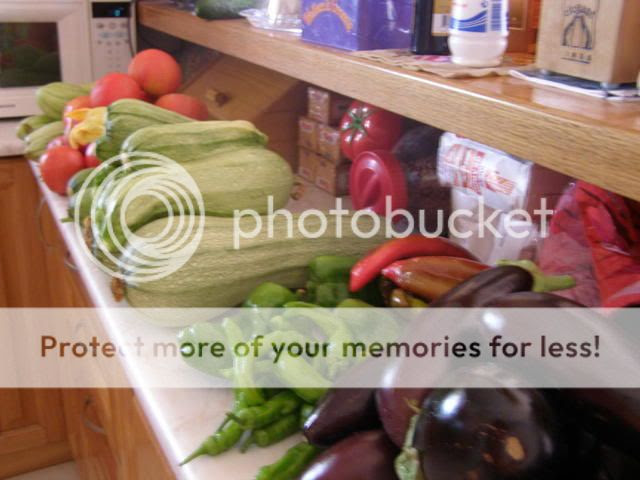
 16. fresh small fish (very popular and very healthy, also cheap, unlike big fish), like fried atherina, marida, sardela, gavros
16. fresh small fish (very popular and very healthy, also cheap, unlike big fish), like fried atherina, marida, sardela, gavros
 17. fresh orange juice - Western Crete is an orange-producing area; the drop in local orange sales, due to low prices and the difficulties (and expense) associated with transporting fresh produce away from the island, has marred the local economy, but the fact is that Cretan citrus is still very high quality...
17. fresh orange juice - Western Crete is an orange-producing area; the drop in local orange sales, due to low prices and the difficulties (and expense) associated with transporting fresh produce away from the island, has marred the local economy, but the fact is that Cretan citrus is still very high quality...
http://organicallycooked.blogspot.com/2008/04/carbon-footprint-less-orange-juice.html

 18. spoon sweets (eg quince, fig, citrus species), especially accompanied by yoghurt (as an evening meal instead of a main meal); this again is part of general Greek cuisine, but Cretan desserts don't differ greatly from mainstream society! The good thing about this kind of dessert is that, if you are lucky, you will be able to try it for free after a meal at a taverna, because it is usually the after-dinner house treat.
18. spoon sweets (eg quince, fig, citrus species), especially accompanied by yoghurt (as an evening meal instead of a main meal); this again is part of general Greek cuisine, but Cretan desserts don't differ greatly from mainstream society! The good thing about this kind of dessert is that, if you are lucky, you will be able to try it for free after a meal at a taverna, because it is usually the after-dinner house treat.

 18. spoon sweets (eg quince, fig, citrus species), especially accompanied by yoghurt (as an evening meal instead of a main meal); this again is part of general Greek cuisine, but Cretan desserts don't differ greatly from mainstream society! The good thing about this kind of dessert is that, if you are lucky, you will be able to try it for free after a meal at a taverna, because it is usually the after-dinner house treat.
18. spoon sweets (eg quince, fig, citrus species), especially accompanied by yoghurt (as an evening meal instead of a main meal); this again is part of general Greek cuisine, but Cretan desserts don't differ greatly from mainstream society! The good thing about this kind of dessert is that, if you are lucky, you will be able to try it for free after a meal at a taverna, because it is usually the after-dinner house treat.
 19. watermelon and feta, in combination, as an evening meal instead of a main meal, accompanied with paximathi (dry bread rusk); even though feta cannot be considered a Cretan cheese variety, it is also made here by local cheese producers, albeit under a different name (telemes, lefko tiri), because feta cheese now has a PDO label.
19. watermelon and feta, in combination, as an evening meal instead of a main meal, accompanied with paximathi (dry bread rusk); even though feta cannot be considered a Cretan cheese variety, it is also made here by local cheese producers, albeit under a different name (telemes, lefko tiri), because feta cheese now has a PDO label.
 20. xerotigana (for dessert, or as a sweet snack); even though they are vegan, and contain very few ingredients, they are to the Cretans what the macaron is to the French.They are a traditional Cretan wedding/baptism dessert.
20. xerotigana (for dessert, or as a sweet snack); even though they are vegan, and contain very few ingredients, they are to the Cretans what the macaron is to the French.They are a traditional Cretan wedding/baptism dessert.Fear not - you don't need to be invited to a wedding to try xerotigana. They are also sold in the Agora, where most of the food in the above list can also be found, cooked or in its primary form (ie the ingredients to make everything can be brought here).
The cost of the meals I have showcased is actually quite low, apart from the ahinosalata (it is considered a delicacy; I think myself lucky if I eat it once a year), the goat/rabbit (although these are local meats, they are more expensive than pork and chicken, with lamb somewhere in the middle), and maybe the orange juice (if you drink it at an upmarket cafe). You can eat out very cheaply in most places all around Greece. Just beware of the tourist traps, which every tourist should be aware of when they are travelling to a foreign place:
- Hawkers outside tavernas: they're begging you to come in; the quality and cost of the food will reflect that.
- Sightseeing areas: you're paying for the atmosphere, not the food; the owners know that they won't need to see you again.
- Non-local food: if you know what the area is known for in terms of food, then you should avoid choosing items that aren't seasonal or don't have a Greek name; there is a growing tendency to serve globalised cuisine in many places these days, but it is likely to be more expensive too.
- Go where the locals go: it isn't far from the truth to admit that where there are a lot of locals, the food and prices will meet your demands better than a place that seems to be full of tourists like yourself. You may not be able to distinguish the locals, but surely you won't be able to miss the tourist: s/he is usually dressed like one (pouch bags, white socks and Birkenstock sandals, rucksack hung on a chair).
 1. the Agora: located in the town centre, the main market of Hania has well cooked traditional food at good prices; it is also a chance to see Cretan food in both its fresh and cooked forms.
1. the Agora: located in the town centre, the main market of Hania has well cooked traditional food at good prices; it is also a chance to see Cretan food in both its fresh and cooked forms.
 2. Botanical Park , a more modern approach to the Cretan dining experience, focussing on traditional Cretan produce (you need a car to get there); it is also hosts a beautiful Botanical Park (including non-local plants), as its name suggests.
2. Botanical Park , a more modern approach to the Cretan dining experience, focussing on traditional Cretan produce (you need a car to get there); it is also hosts a beautiful Botanical Park (including non-local plants), as its name suggests.
 3. a seaside taverna, like the ones I have been to: Akrogiali, Koumandros, Salavantes, and Waves on the Rocks (depending on which part of Hania you find yourself); eating by the sea under the Mediterranean sky, especially in the cool of the shade in the early evening is an unforgettable experience.
3. a seaside taverna, like the ones I have been to: Akrogiali, Koumandros, Salavantes, and Waves on the Rocks (depending on which part of Hania you find yourself); eating by the sea under the Mediterranean sky, especially in the cool of the shade in the early evening is an unforgettable experience.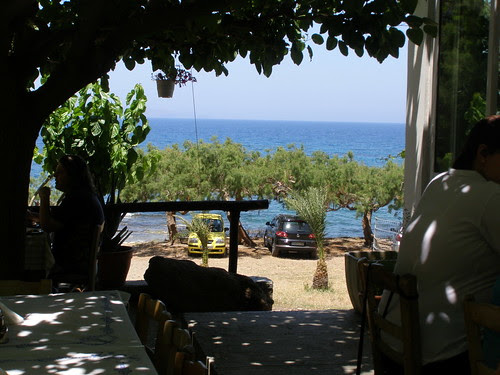
 4. Koutroulis, for a taste purely traditional Cretan food in a traditional setting; most tourists to |Hania visit Omalos in the mountains, as it is where the Samaria Gorge starts.
4. Koutroulis, for a taste purely traditional Cretan food in a traditional setting; most tourists to |Hania visit Omalos in the mountains, as it is where the Samaria Gorge starts.
 5. Monastiri, for good food and good views, combined with reasonable prices - I go here when I want to impress friends.
5. Monastiri, for good food and good views, combined with reasonable prices - I go here when I want to impress friends.
 6. a cafe like The Red Bicycle (for breakfast)
6. a cafe like The Red Bicycle (for breakfast)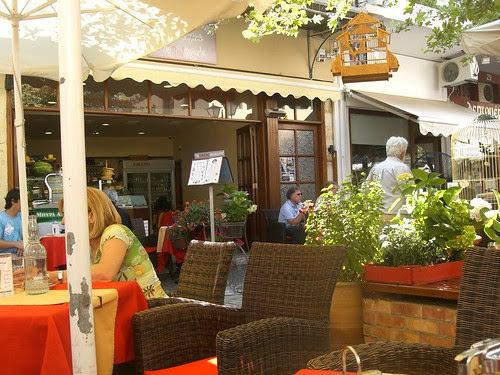
 or Fortezza (in the evening) because it has atmosphere and peace and quiet - sometimes, the food is not as important as these two factors!
or Fortezza (in the evening) because it has atmosphere and peace and quiet - sometimes, the food is not as important as these two factors!
But the food is not just what you come for to Crete. Make sure you don't miss out on these amazing beaches in Western Crete, which I highly recommend, with one caveat: they are all greenhouse crop growing areas. You will see from afar the white plastic blanket covering each area – it looks kind of gross. But the sea is very clean (look out for the 'blue flags', as designated by the EU).
 1. Falasarna
1. Falasarna
The names (in brackets) next to the link give the locations of the coastline with blue flags. They are further away from the town of Hania, but the list of blue flags in the area also contains beaches that are much closer to the town. In my recommendations, only Falasarna does not have a blue flag listing this year, although it did last year (I wonder if the greenhouses have had anything to do with this). Still I include it in my list of must-visit beaches, because it is simply too beautiful to miss out on...
 If you fly into Crete (or take the ferry boat from Athens) via Iraklio, you may be wondering if you are actually on a Greek island once you leave the port areas. Iraklio is not the prettiest part of Crete. But as the capital of Crete (a title it took away from Hania in the 70s), it is the most organised! Cretans go to Iraklio for business or medical reasons (it has larger hospitals); Rethimno is largely agricultural, while Hania is a summer tourist resort.
If you fly into Crete (or take the ferry boat from Athens) via Iraklio, you may be wondering if you are actually on a Greek island once you leave the port areas. Iraklio is not the prettiest part of Crete. But as the capital of Crete (a title it took away from Hania in the 70s), it is the most organised! Cretans go to Iraklio for business or medical reasons (it has larger hospitals); Rethimno is largely agricultural, while Hania is a summer tourist resort.
It rarely gets better than this in Hania.
 As you leave Iraklio and head west, you will pass through the province of Rethimno. From here, you may want to wander off the beaten track and go inland. I recommend finding your way to the village of Margarites (Rethimno) which is well-known in the area for its pottery, and then on to Arkadi which has a famous monastery, and finally onto Lake Kournas, a pretty and relaxing spot away from the crowds, before finally coming into the province of Hania. Before hitting the beaches, try visiting Omalos to see the Samaria Gorge (you can walk the gorge as a day-trip). A visit to the old Venetian port near the town centre will leave you breathless. Most of the hotels that open in the summer only (which includes most of them) have a swimming pool, so you can sit by the pool and drink your Maritinis, if that's the kind of holiday you want. But you can do that anywhere in the world, so why not take a picnic lunch which you can buy from the local manaviko or the supermarket, and hit the beaches for something more unique?
As you leave Iraklio and head west, you will pass through the province of Rethimno. From here, you may want to wander off the beaten track and go inland. I recommend finding your way to the village of Margarites (Rethimno) which is well-known in the area for its pottery, and then on to Arkadi which has a famous monastery, and finally onto Lake Kournas, a pretty and relaxing spot away from the crowds, before finally coming into the province of Hania. Before hitting the beaches, try visiting Omalos to see the Samaria Gorge (you can walk the gorge as a day-trip). A visit to the old Venetian port near the town centre will leave you breathless. Most of the hotels that open in the summer only (which includes most of them) have a swimming pool, so you can sit by the pool and drink your Maritinis, if that's the kind of holiday you want. But you can do that anywhere in the world, so why not take a picnic lunch which you can buy from the local manaviko or the supermarket, and hit the beaches for something more unique?Crete is generally an island for nature lovers, not urbanites. As a visitor, there is rarely an occasion where formal dress is essential. This easy-going lifestyle is not being replaced, although it is being modernised in the globalised modern world that we are living in. Crete has more to offer than just good food and good coastlines. I happen to live in some of the most beautiful scenery in the world. The mountains and inland villages are worth another entire post - but you'll have to wait for that one to come up on my blog in the cooler weather, so that I can entice you to enjoy Crete all year round!
*I can imagine what the waiter-owner will probably be thinking about this kind of customer: "He came all the way up here to eat kalamaria, poor sod."
©All Rights Reserved/Organically cooked/Zambolis Chania Studios. No part of this blog may be reproduced and/or copied by any means without prior consent from Maria Verivaki.

